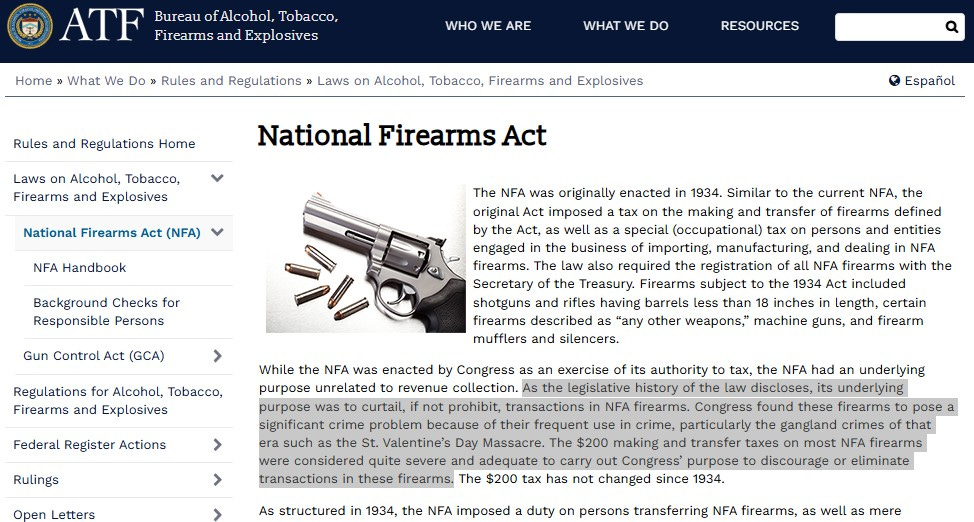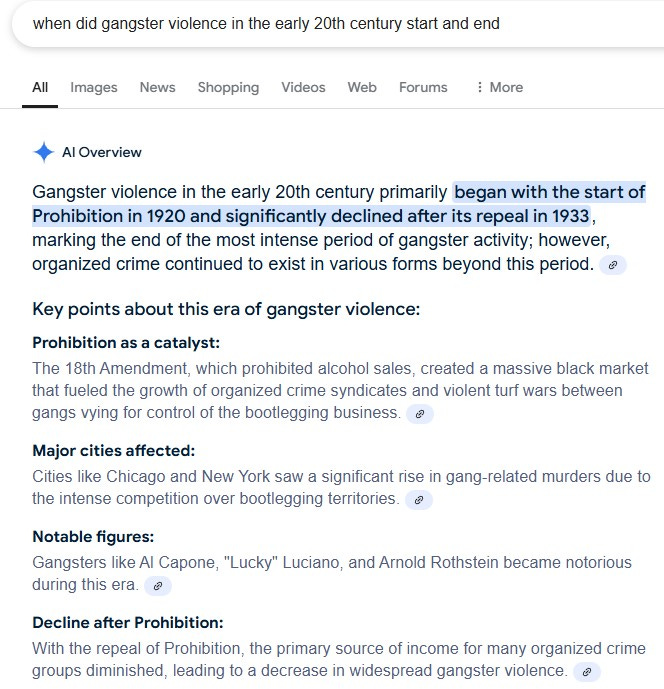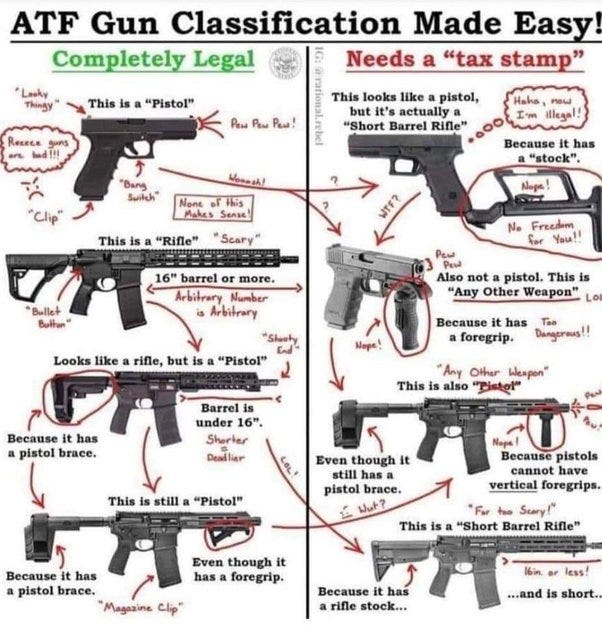Why The NFA Should Be Repealed
An In-depth Analysis
This piece is being cross posted here and at The Bangswitch. Yes, you read that right, The Bangswitch is back!
If you are into guns, you have probably heard staunch Second Amendment advocates discuss repealing the “NFA.” Most non-gun folks, and even many casual gun owners, do not even know what the NFA is. The NFA is short the National Firearms Act and it was signed into law in 1934. It regulates several categories of firearms and firearm accessories which includes, but is not limited to, short barreled rifles, short barreled shotguns, machine guns and suppressors (silencers).
This piece is going to run a bit long because it is a topic that deserves serious examination, but for those of you in the audience who need instant gratification, jump down to the summary near the end.
History of the NFA
After more than a decade of rampant “gangster” violence perpetrated using all sorts of legal, readily available firearms to include handguns, short barreled shotguns, short barreled rifles and machine guns, many members of congress decided they wanted to outlaw many of the guns that were being used so the NFA was drafted. In fact, the original version of the bill even included handguns.
Handguns were eventually dropped from the bill when they realized including them was sure to have the law overturned for being unconstitutional. It was agreed that there would be much less argument from the general public if it only covered short barreled shotguns and rifles, machine guns and silencers, things that were being employed by the violent gangsters of the day. They were not wrong.
While the handgunless version of the bill was verbally agreed upon in both houses with very little disagreement, there were never any official votes cast for the bill, HR9741 of the 73rd Congress. Somehow the bill skipped being voted on in either house and magically made its way to the president’s desk and was signed into “law.” I was dubious about this fact myself, until I went and looked for the vote record for the bill and found it does not exist.
In what would become a very normal pattern for gun control legislation, this bill was authored and sponsored by members of the Democrat party, and was opposed by members of the Republican party. Unfortunately, the Democrats had unbeatable majorities in both houses of congress, and FDR (a Democrat) was the president. The bill was introduced and five days later, after only very minor changes, and no official votes recorded in either chamber, it was signed into law by FDR.
I highly encourage you to do more reading about the history of the NFA. Those who fail to learn from history tend to repeat it.
Stated Purpose of the NFA
The very congress that passed the NFA realized that they could not outright ban certain firearms as that would be deemed unconstitutional, so instead they decided to tax them very heavily. They also freely admitted the purpose of the NFA and the $200 tax was designed to make ownership of certain firearms cost prohibitive.
To understand just how onerous that $200 tax was in 1934, according to the CPI Inflation Calculator, $200 from 1934 is about $4,710 today.
The modern ATF also admits the initial intent of the NFA on their government website.
“As the legislative history of the law discloses, its underlying purpose was to curtail, if not prohibit, transactions in NFA firearms. Congress found these firearms to pose a significant crime problem because of their frequent use in crime, particularly the gangland crimes of that era such as the St. Valentine’s Day Massacre. The $200 making and transfer taxes on most NFA firearms were considered quite severe and adequate to carry out Congress’ purpose to discourage or eliminate transactions in these firearms.”
But Why All The Gangster Violence?
If you look at the discussions that took place in order to justify passage of the NFA, it all centered around “gangster violence.” While it cannot be argued that there was indeed a plethora of violence being perpetrated by organized crime, one cannot just take that fact at face value. What was going on that caused the organized crime of the day to erupt into public gun battles?
Enacted in 1920, Prohibition was the law of the law, and it birthed massive numbers of organized crime families vying for control of their territories where they ran the illegal liquor business. Those fights over territory eventually turned into those gun fights, often employing firearms like the Thompson submachine gun.
Prohibition was overturned in 1933, and in completely unsurprising news, the violence started to subside even before the NFA was passed. Any claims that the NFA was responsible for the drop in violent crime of the time are dubious at best.
Despite the already declining organized crime violence, those seeking to prevent Americans from having access to guns covered by the NFA used the already declining violent crime spree as justification for the law.
Heller & The NFA
In 2008, the US Supreme Court ruled in District of Columbia v. Heller that the Second Amendment did in fact protect a citizen’s right to own firearms for self-protection, but they concluded that it did not protect guns that were “dangerous or unusual.” In ruling so, they said that it protected the right to possess weapons that were "in common use" and "typically possessed by law-abiding citizens for lawful purposes."
With that in mind, we should take a look at some of the devices that fall under the NFA and see just how many of them there are. As of May 2021, and according to the Bureau of Alcohol, Tobacco and Firearms (ATF), there were 741,146 legally registered machine guns, 532,725 registered Short Barreled Rifles (SBRs), and 2,664,774 registered suppressors all in civilian hands.
When speaking about SBRs, it is worth noting that the ATF recently attempted to make a rule change on braced pistols, claiming that they were suddenly to be considered SBRs. When that happened, another 255,162 were registered before the May 2023 deadline, bumping the total for registered SBRs to 787,887.
Worth noting, since that May 2023 deadline passed, the ATF’s processing time for NFA paperwork has shortened dramatically. What used to average around 9-10 months now takes about a week. Due to the very short wait times, sales of all things NFA has increased significantly, as have people converting guns themselves and registering them.
The gun shop I work at sold 3.5 times as many suppressors in 2024 than we did in 2023, and I know we are not an anomaly. According to one article I read, the NSSF said that Americans purchased over 1.4M suppressors in the first 6 months of 2024 alone.
Let’s Split Some SBR Hairs
Back when the ATF tried to force their rule change regarding pistol braces, the pure absurdity of the difference between an SBR and a braced pistol started to become more widely known amongst the general public. There were videos showing a braced pistol compared to a SBR, and even with the difference pointed out, most “regular” people could not tell the difference. And that is because there is hardly any difference at all.
The ONLY difference between a legal braced pistol and an SBR (either legal or illegal depending on if it is registered) is if it has a brace or a stock on the butt end of the gun. On an AR platform firearm, those parts can literally be swapped in seconds without tools.
Taking this a step further, the NFA does absolutely nothing to prevent people from obtaining or building illegal SBRs, since it takes mere seconds to change a legal pistol into an illegal SBR and then change it right back. For that matter, it is not even necessary to have a brace on your AR pistol, so merely removing the stock returns an illegal SBR to a legal pistol.
It is such a convoluted process that many casual gun owners cannot comprehend the difference, and I guarantee the non-gun owning general public can’t tell the difference.
Since the ATF wants to say that braced pistols are SBRs, and since it is so easy to change a braced pistol into an SBR (whether or not you do it legally), and since both firearms are the same size and can be used in a similar manner, we should at least for sake of an NFA argument, acknowledge that the two classification of firearms are notably similar.
Acknowledging the similarity, what does that do to the numbers? At the time the ATF was trying to force registration of braced pistols as SBRs, the ATF themselves estimated that there were between 3-4 million braced pistols in the US. The Federal Congressional Research Service disagreed though. Their estimate put that number somewhere between 10-40 million, and they based that on the number of pistol braces that had been sold in the preceding decade.
“Common Use”
Just what exactly constitutes “common use?” Unfortunately, the SCOTUS did not elaborate on that. This is a topic that multiple state appellate courts are trying to resolve. Is 500k common? Is it one million? Personally, I think you would be hard pressed to argue that over 1,000,000 of anything does not constitute “common use.”
Currently, based on 2021 numbers alone (2,664,774), suppressors clearly qualify as something in common use. When you add up all the suppressors sold in the years since, with an estimated 3 million last year alone, the total number is likely more than 7M at this point.
In terms of SBRs, and if you consider that the ATF wants to count braced pistols as SBRs, the number of those is, at the very lowest at least 4M, and at the highest over 40M. Clearly, SBRs are also in “common use.”
Machine guns in common use is a chicken and the egg argument. Since the passing of the Gun Control Act of 1968 and the Firearm Owners Protection Act in 1986, no new legal machine guns have been available for sale to the public. The only legal machine guns a civilian can own were all made and registered prior to 1986. With a set number of guns available, their prices have skyrocketed. Additionally, there has been zero growth in their numbers because the laws prevent that from happening.
Looking at the growth in ownership of other NFA items like suppressors and SBRs, it is easily argued that if sales of new machine guns had not been outlawed, that the number of them would absolutely have grown at the same rate. So, while they may not be in common use, it is because the law is preventing them from being in common use.
You can’t use the artificial effects of a law limiting common use as a argument to support the constitutionality of a law prohibiting ownership based on the fact that they are not in common use. It is circular logic and it does not pass muster.
“Lawful Purposes”
If suppressors are so common, they must be used in crimes all the time, right? Not so. According to the ATF, on average they only recommend prosecution in about 44 suppressor cases annually, and the majority of those are mere possession or construction cases. The number of crimes involving suppressors is so ridiculously low that even the ATF has at times in the past argued that they should be deregulated.
In fact, we are one of the only countries that treats suppressors the way we do. In most other countries where civilians can own firearms, suppressors are sold as over the counter accessories and some countries even require them for hunting.
Tracking the use of SBRs in crime is a bit more difficult as there is no reporting category specifically for them. Considering the fact that they are rifles, they make up a subset of rifles used in crime. Rifles only account for about 3% of weapons used in homicides, thus making SBR’s lower than that since they are a subcategory of rifles.
In 2023 there were 511 murders where a rifle was the murder weapon. Even if we stick to just the lowest number of SBRs that we know exist, the number of legally registered SBRs as of May 2023, which was 787,887, and if we for the sake of argument say that every single rifle used in a murder was an SBR, that would mean that only 0.06% of SBRs were used in a homicide. Meaning that 99.94% of SBRs were used for “lawful purposes.” Then if you start looking at the larger numbers, like the potential of 4M SBRs, or the highest estimate of 40M, that percentage gets astronomically smaller, and even smaller still. There is absolutely no evidence that SBRs pose any significant threat to anyone.
Now if you want to talk about machine guns, the stats are non-existent because legally owned machine guns are quite literally never used in crimes. Yes, illegally converted fully automatic weapons are being used in crimes fairly regularly (gang shootings involving Glocks with illegal switches installed). My former department, the Sacramento Sheriff’s Department, has had a number of shootings where the suspect was armed with an illegal, fully automatic Glock or Glock clone.
But then most of those guns were illegally obtained to begin with, and the people wielding them are very often prohibited persons. If anything, the prevalence of illegal machine guns showing up in shootings is actually an argument that the NFA does not have any bearing on gun crimes and therefore it serves no purpose.
Bullet Point Summary
The NFA is unconstitutional and they knew that when they were discussing it in Congress back in 1934, so rather than ban the guns outright, they decided to heavily tax them.
The NFA was never voted on by either chamber of congress so technically it should have never been before the president to sign. Since the NFA was never voted on by congress, technically speaking it was never legally passed and as such it should not even be considered a law.
The NFA’s creation was justified using criminal activity that was specifically generated by another federal law (prohibition), a law which they had just repealed for which the violent crime was already dwindling.
The NFA does absolutely nothing to prevent or deter “gun violence.” Neither suppressors nor short barreled rifles play any significant role in crime despite there being many millions of them in civilian hands, and despite machine guns being heavily regulated, new illegal machine guns are being found used in gang crime on a fairly regular basis.
Finally, the differences between items covered by the NFA and items that are not are so minuscule it is nearly impossible to differentiate them.







